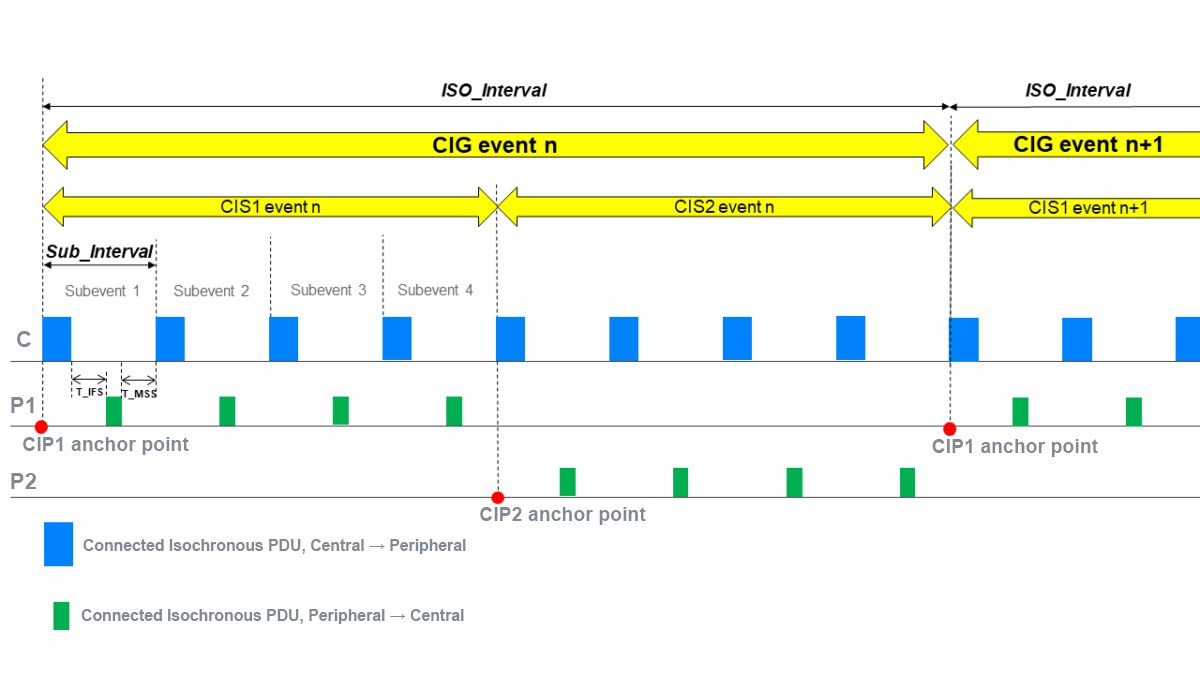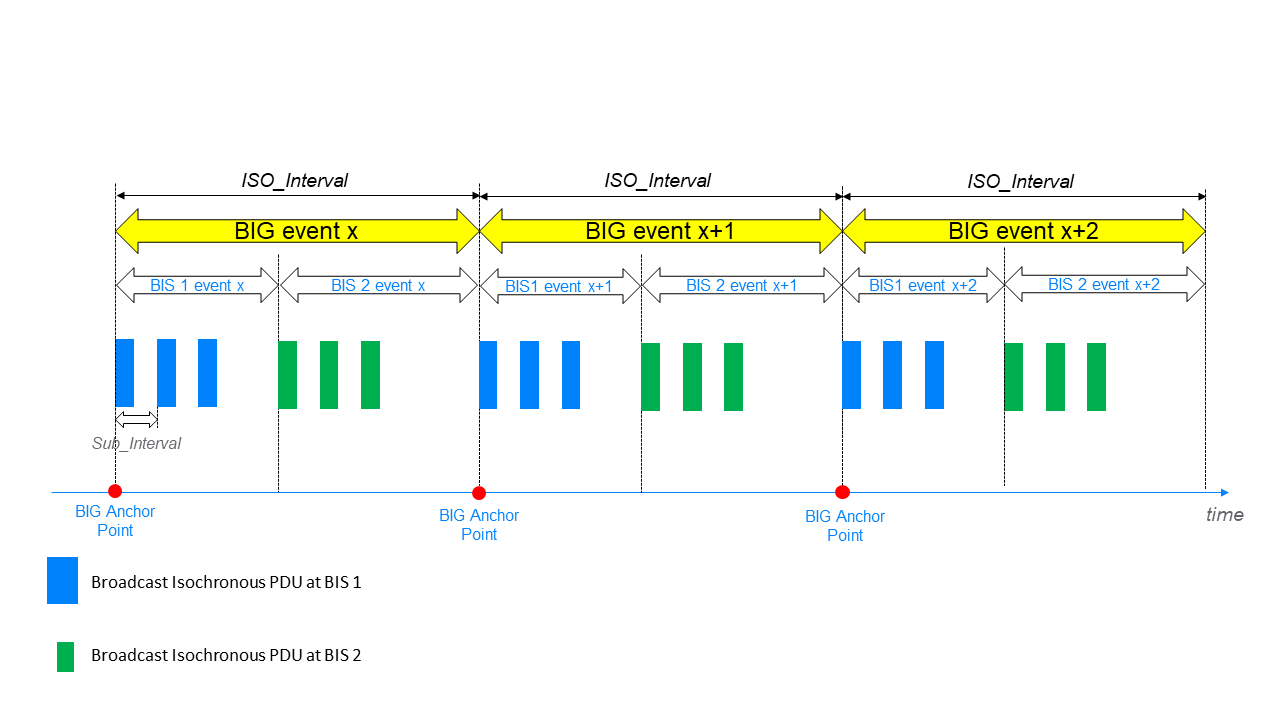Bluetooth LE Audio is the next generation of Bluetooth® audio and operates on the Bluetooth Low Energy (LE) radio, compared with Classic Audio, which operates on the Bluetooth Classic radio, also known as the Bluetooth BR/EDR radio. Isochronous Channels are one of the key features introduced in Bluetooth® Core 5.2. Isochronous Channels, along with Bluetooth profiles that are currently in development, will help enable Multi-Stream Audio and Broadcast Audio for Auracast™ broadcast audio. The aim of this article is to give developers a fundamental introduction to this use case and to answer some common questions.
Multi-Stream Audio is one of the major new features for LE Audio. It enables the transmission of multiple, independent, synchronized audio streams between an audio source device, such as a smartphone, and one or more audio sink devices like earbuds or earphones. To support Multi-Stream Audio, Connected Isochronous Group (CIG) and Connected Isochronous Stream (CIS) were introduced. A CIG is created by the central and it can include one or more CISs. A CIS is a point-to-point, data transportation stream between a central and a certain peripheral, and is a bidirectional communication protocol with acknowledgment. Furthermore, a CIS can be divided into at least one or more subevents, and these subevents are the timing slot for central and peripheral to exchange data packets using specific Connected Isochronous PDU.

Figure 1 shows a CIG, which includes 2 CISs. Each CIS includes 4 subevents.
Auracast™ broadcast audio is an important capability of Bluetooth LE Audio. It enables an audio source device to broadcast one or more audio streams to an unlimited number of audio sink devices. To support Auracast™ broadcast audio, Broadcast Isochronous Group (BIG) and Broadcast Isochronous Stream (BIS) are introduced. There are two types of devices: Isochronous Broadcaster and Synchronized Receiver. A BIG is created by an Isochronous Broadcaster and it can include one or more BISs. A BIS is a one-to-many data transportation stream. It uses the broadcast packet transportation mechanism without acknowledgment. Furthermore, a BIS can also be divided into one or more subevents. These subevents are the slots for broadcasting specific Broadcast Isochronous PDU which can be received and processed by unlimited Synchronized Receivers.

Figure 2 shows a BIG, which includes 2 BISs. Each BIS includes 4 subevents.
Common questions developers have about Isochronous Channels include:
How many CISs can a CIG create?
The maximum number of CISs in a CIG shall be 31.
What’s the process the central uses to create a CIS with a peripheral?
Please refer to Bluetooth® Core 5.2, Vol 6, Part B, Section 5.1.15, “Connected Isochronous Stream Creation procedure”.
For a single peripheral, how many CISs can a central create with it?
The central can create one or multiple CISs with a single peripheral. The maximum number of CISs in a CIG shall be 31.
Can CIS be encrypted?
Yes, it can be encrypted, please refer to Bluetooth® Core 5.2, Vol 6, Part B, Section 4.5.13.7.
How do the central and peripheral detect a CIS lost?
When establishing a CIS, the central shall start a CIS supervision timer to monitor for the loss. If the CIS supervision timer reaches 6 * ISO_Interval before the CIS is established, the CIS shall be considered lost. The peripheral also starts the CIS supervision timer. If it reaches 6 * ISO_Interval before the CIS is established, the CIS shall be considered lost in the peripheral side.
If the CIS has been established, when the supervision timer reaches the connSupervisionTimeout value, the CIS shall be considered lost. Please refer to Bluetooth® Core 5.2, Vol 6, Part B, Section 4.5.2.
How does a Synchronized Receiver detect lost with an Isochronous Broadcaster?
A device that has synchronized to a BIG is called a Synchronized Receiver. When this device starts to synchronize the BIG, a BIG synchronization timeout parameter shall be configured, which specifies the maximum permitted time between successful receptions of BIS PDUs. The timeout is at least 6 * ISO_Interval.
How many BISs can be created in a BIG?
The maximum number of BISs in a BIG shall be 31.
Can BIS be encrypted?
Yes. Please refer to Bluetooth® Core 5.2, Vol 6, Part B, Section 4.4.6.10.
Can Constant Tone Extension (CTE) be appended after the Cyclic Redundancy Check (CRC) of Isochronous Channels packets?
For Isochronous Channels, it has its own Isochronous Physical Channel PDU and it doesn’t include a CTE field. For additional details, please refer to Bluetooth® Core 5.2, Vol 6, Part B, Section 2.6. From the LE Link Layer level, it is still allowed to use Advertising Physical Channel PDU or Data Physical Channel PDU for CTE.
Besides LE 1M, can Isochronous Channels support LE 2M and LE Coded?
Yes, CIS allows that the PHY used from central to peripheral is different than the PHY used from peripheral to central.
Download the Bluetooth® Core 5.2 Feature Overview [PDF] to learn more.